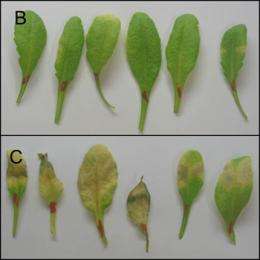Salmonella uses similar mechanism to infect plants and humans

In recent years, it has become clear that food poisoning due to Salmonella typhimurium can be contracted not only by uncooked eggs and meat but also through eating contaminated raw vegetables and fruit. So far, it was unclear how these bacteria can infect humans and plants alike. A team associating researchers from INRA, CNRS and the Universities of Evry (France), Giessen (Germany) and Vienna (Austria), has shown that Salmonella suppress the defense systems of plants and humans by a similar mechanism. Moreover, the teams showed that plants contaminated with Salmonella are highly infectious to human cells and mice. The results were published in PLoS ONE on September 6, 2011.
Salmonellosis is one of the most common types of food poisoning induced by bacteria from the genus Salmonella. Every year 100 million people are infected throughout the world by what is the primary cause for gastro-enteritis and typhoid fever. Until recently, it was thought that humans become infected by eating contaminated products of animal origin only (meat, eggs, milk). However, there has been a significant increase in the past 10 years of people infected by Salmonella having ingested raw vegetables. Research showed that contaminated vegetables and fruits equally have to be considered as vectors to transmit Salmonella to humans and that the bacteria are thus found throughout the food chain.
Recent evidence indicates that Salmonella attack plants in a highly sophisticated manner. They not only attach to plant cell surfaces but also sense and migrate towards pores of leaves for getting access to the interior of plants. For successful infection of human cells, a complex cocktail of virulence proteins is injected by Salmonella by a needle-like apparatus. The virulence proteins switch off the human defense system and allow the bacteria to enter and replicate inside human cells. Researchers at INRA in Evry and Tours as well as of the Universities of Giessen and Vienna now show that Salmonella also suppress the plant defense system by using the same mechanism. The group of scientists also showed that contaminated plants are highly infectious to human cells and mice, thereby raising new concerns about food safety and disease control.
Humans and plants are not powerless to an attack by Salmonella. Plants and animals have developed sensors to perceive a Salmonella attack and activate their respective immune systems. It is often a question of speed and quantity of the host defense responses that determines whether of an attack by Salmonella will lead to disease of the host or defeat of the bacteria. Interestingly, some plant varieties were found to be highly resistant to Salmonella infection whereas other varieties were easy prey for the bacteria.
Today, along with Escherichia coli, Salmonella belong to the best-studied bacteria. To understand the mechanisms by which these bacteria infect plants and how plants protect themselves may offer new insight into infection mechanisms and should contribute to diminish the number of vegetable- and fruit-related infections.
More information: Schikora A, et al. (2011) Conservation of Salmonella infection mechanisms in plants and animals. PLoS ONE, September 6, 2011
Provided by CNRS

















